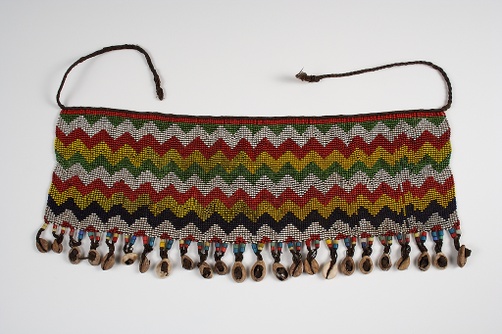
Object Label
The Kirdi are one of a number of small farming communities living in the Northern Cameroon and Southern Chad area. They are known for their arts of personal adornment, including beaded aprons. Women among this group would wear only these aprons around the waist area. Westerners call them Cache Sexes, a French term that literally means “to hide the sex.” Originally, the aprons were made of iron strips held in place by a belt of fiber. However, since the introduction of beads to this area in the 20th century, the Kirdi have adopted this medium.
The different styles of these aprons denote age, female circumcision, widowhood, tribal origin, and the elevated status of mature married women in Kirdi society. There is limited information written about the specific connotations of the designs and their purposes. They generally have a range of bright colors and geometric patterns that most likely come from the influence of neighboring tribes or the surrounding landscape. The cowrie shells, which hang from the bottom of the apron and were formerly used as money, could represent prestige or a symbol of higher status in the community. In the 1960s governmental restrictions required women to be fully clothed. This prohibition explains the recent influx of the aprons in the international art market, thus explaining how the Tang acquired them.
–Bay Danforth ‘03
From the exhibition: Africa Embodied:
The Language of Adornment (November 29 – December 21, 2001)
